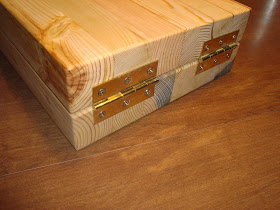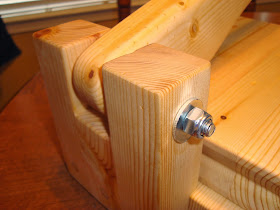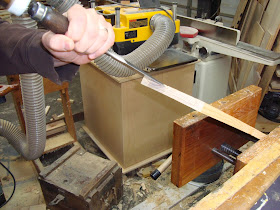We needed a small set of shelves for our tiny cabin I first mentioned
here to use as general storage. I decided to build a set out of spruce to match the existing furniture in the room. I considered doing a pretty typical set with through dadoes in the sides to hold the shelves, and rabbets at the joints between the top and sides and bottom and sides. I wanted to try out making half blind dovetails by hand, just because I never had. So I decided to use that joint to join the top and sides and bottom and sides. Another design goal was to keep it light and easy to transport. To address this, I decided to make it without a face frame. But I didn't want the through dadoes in the sides showing from the front, so I decided to do stopped dadoes to hold the shelves.
I began by crosscutting and ripping my boards down to size.
Right away, I discovered that I had not bought enough stock for the project. I was counting on some additional stuff I had on the lumber rack to work, but it turned out not to be big enough. Being a cheapskate, I decided to just laminate up some scrap I had on hand to make up the difference. I began by jointing one side of each piece.
Then I put some biscuit slots in the two pieces to be laminated.
I applied glue to both pieces clamped on edge, and then put the biscuits in and clamped them up.
Then I turned my attention to the half blind dovetails. I started out by making the tails. This is done just the same way as if you were making through dovetails. I first make layout marks.
Then I cut down the sides of the tails with a handsaw.
Then I chisel away the waste. I chisel in half the thickness of the board from one side, then flip it over and chisel to meet the first cut.
Here is what it looks like at the half way point.
And, finished.
Then I use the tails to make the layout marks on the end of the board where the sockets will go. The rest of the lines are made with marking gauges and my marking knife to complete the shape.
Making the sockets begins with the saw. I cut in on the edge of the board just on the waste side of the line. This, of course, only allows you to go part of the way as deep as you need to.
Then I come in with the chisel and mallet to define the inside vertical section of the joint.
Then I take the chisel and mallet in from the end grain to remove the remaining waste.
And here are the finished sockets.
Here is one of the joints test assembled.
Once all 4 corners are made in this fashion, I begin layout for the stopped dadoes that will hold the shelves. I clamp the sides together and square the marks across both at once so the dadoes will match.
Then I square the lines across the inside face of each side with my knife and square.
In keeping with the made by hand theme I had going from the half blind dovetails, I cut the stopped dadoes by hand. The only other way I could come up with to do it was to use a handheld power router, and that just didn't sound like fun to me. I started by deepening my knife marks with a chisel and mallet.
Then I pare into my knife line, creating a relief so the chisel can go in further on the next pass.
I keep repeating this until I reach the full depth I intend for the dado to be. Here you can see one in process at about half the intended depth.
Then I pare in with the chisel from the end to quickly remove most of the waste, but I don't go full depth.
A hand router takes the groove down to its final depth.
The shelf boards need a notch cut into their front so that they can fit into the dado and still sit flush with the sides. I just cut these out with my handsaw.
Some tweaking of the thickness of the shelves is required to get the right fit in the dadoes. Here I am thinning a shelf down a bit with a hand plane.
Then, I got a little dovetail happy and screwed up. This set of shelves is pretty narrow and tall, so I was concerned about it tipping over. I wanted to put in a cleat just inside the top to allow me to screw the shelves to the wall to prevent this. So I made a cleat with a couple of dovetails on the ends.
I cut half blind sockets into the sides to match, but I didn't think about the fact that these sockets were oriented the wrong way with respect to the grain and too near to the ends of the sides and of course the sockets blew out while I was chiseling them. Sheesh. So I cut them off and glued on some pieces to fill in the gaps.
I trimmed and planed them flush. You can make out the patch on the top left in this picture.
Next I planed the sides, shelves, top, and bottom all smooth.
I rounded over the front edges of all the pieces with my router, and sanded everything lightly. Then I glued it up. This required every clamp I had plus 3 new ones. Luckily I realized I needed 3 new ones before I started gluing them up. This is the reason why you are supposed to do a practice run on a big glue up like this before you actually apply any glue, and I'm glad I didn't skip it like I often do.
I went through my usual lengthy finish regiment with 3 coats of brushed on waterborne polyurethane, and here is the finished product at the cabin. You can see it's already making itself useful!















































